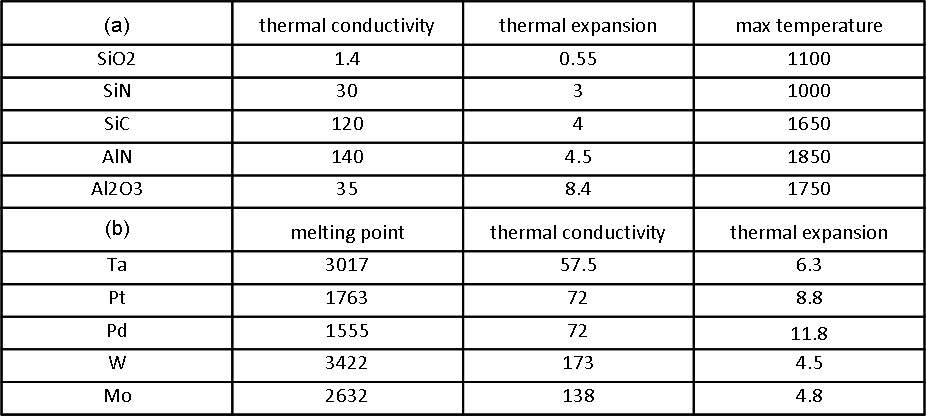IT-7-P-3335 Mems-based heaters for ultrahigh temperature in situ TEM studies
MEMS-based heaters are presently used in situ TEM studies for different purposes and applications such as morphological transformations of gold nanoparticles [1], sculpting of graphene [2], gas nanoreactors [3], thermal stability of nanoparticles [4]. An obvious question is how high we can go with such heaters. The heaters used in references 1-4 were made out of Pt embedded in SiN. Other heater materials like Mo and W can be applied to allow a higher temperature, in particular for temperatures above 1000 0C. Table 1 gives some thermal properties of various materials. Note that these are bulk properties and that for a thin film or in combination with another thin films they can be quite different. The applicability of the various metals depends strongly on the layer package of the membrane and the heater in the MEMS fabrication. For instance we use Pt heaters are embedded in ~500 nm thick SiN membrane, with ~6 µm wide viewing windows of 10-20 nm thick SiN (Figure 2). Since the embedding requires two SiN fabrication steps, Pt has to be stable in the gases used in the second SiN deposition. However, W is not stable in this process and thus embedding of W requires a different fabrication route.
Our MEMS heater contains four electrical connections that allow for temperature determination and heating. The big advantage of MEMS-based heater holder that the heat produced is low and thus little drift. It will be the thickness of the membrane, the size e.g. 1000 µ wide, and its thermal conductivity that determines the heat transfer to the holder. In this respect it is useful to consider the total system from specimen to holder as a set of thermal resistors (Figure 3). The temperature of the sample on a thin window will depend on the heat transfer (and thus the thermal resistances of the components between the sample and the heater. At low temperatures (up to 500°C) the irradiation is relatively small and one can assume that the temperature of the sample is about equal to that of the heater even if the thermal resistance between the thin window and the sample is high. But at high temperature various components of the heater will irradiate which add to the uncertainty of the temperature of the sample.
We are exploring in particular the use of W as heater material, with SiN, SiC and Al2O3 as membrane material. Recently we made heaters that are at least stable at 1250°C over 24 hours and are trying to push this up to 1400°C by a optimization of materials and process steps. We will report on these optimizations in the presentation.
[1] Young, N.P. et.al. Ultramicroscopy 2010, 110, 506-516.
[2] Song, B. et.al. Nano Letter 2011, 11, 2247-2250.
[3] Malladi, S. et.al. Chemical Communication 2013, 49, 10859-10861.
[4] Yalcin, A.O. et.al. Nanotechnology 2014, 25, 055601.
This work is part of the research programme of The European Research Council (ERC) NEMinTEM 267922.


